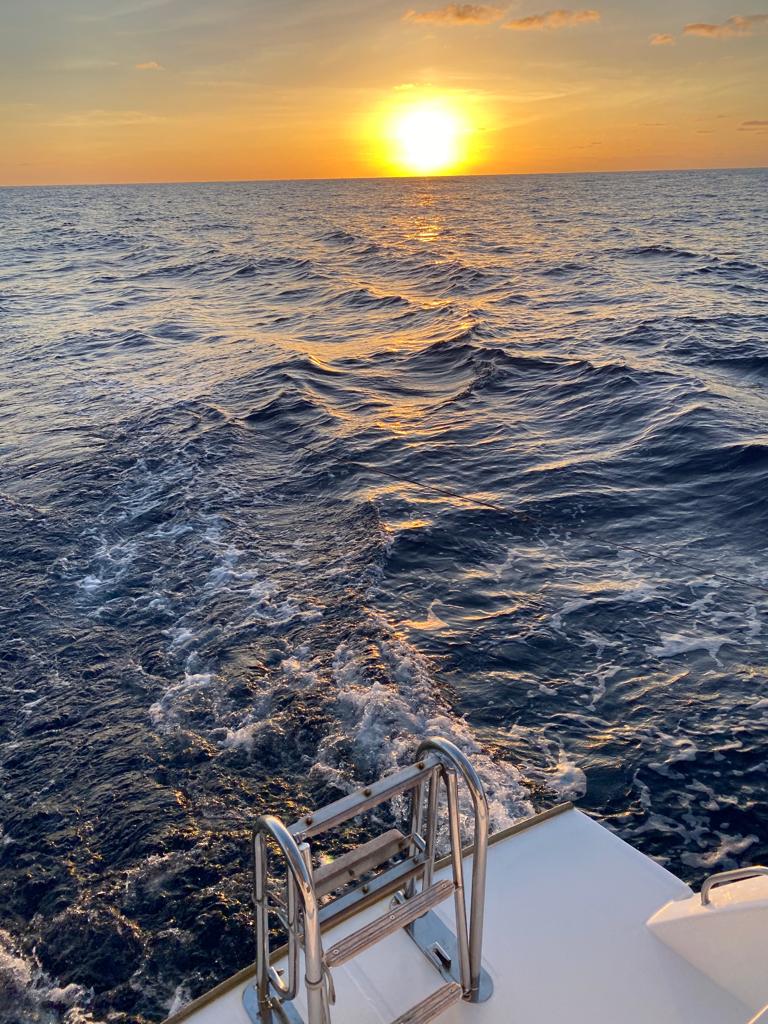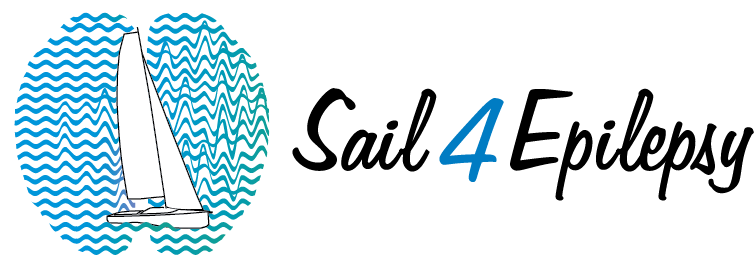@15:15 GMT
Position: 37° 33.575 N x 51° 52.459 W
Speed: 5.6 kts
Course: 85° True
We thought that you might like to know what typical days might look like on board Ingwe. One day for us is a full 24 hours, as we continue to sail through the night towards the Azores. Our lives consist of many different activities while underway, ranging from being on watch, to cooking, eating, maintenance and delivering the Sail For Epilepsy program. The past two days have been action packed in most areas, with each day dominated by different needs. For the project to be a success, we must sail the oceans of the world while delivering a program of inspiration, education, and awareness. Beneath is a timeline of the past 2 days that highlight these components.


May 26, 2022: Sailing – or not sailing – the boat
0400 Lauren and Rudy are on watch, when a squall comes through. The sails are already reefed and ready for the conditions, which are forecasted to subside throughout the morning.
0600 The entry in the log book shows that we’ve beat our previous 24h record by achieving 238nm sailed.
0630 Rather than subsiding, the conditions have been building for several hours. Phil and Emily are now at the helm. We have kept the sails reefed to reduce the sail area and the winds keep climbing. True wind speed is now 40knots. We heave to (in effect stop the boat and let it ride out the storm. See below for an account by Phil, Rudy, and Lauren, each from differing perspectives).

0700 All the crew is awake and now it is time for coffee and tea to be drunk. We are all tired but we need to stay alert. The winds are expected to subside but they have built up a significant sea state.
0745 Phil is asked “how long will it last?” “Several hours, probably until this evening” he answers.
1000 During the daytime it was quite magical to watch the sea rise and fall around us, while we drifted slowly west and north, retracing our track line. We felt very safe, 1000nm from any help. The crew takes advantage of the down time to play cards, read and nap, as there wasn’t much rest the night before.
1100 Phil writes a blog about the storm and sail trim while Lauren edits videos. All work is slow with the constant pitching of the vessel. One crew member stands by the helm at all times, occasionally making slight corrections as needed. The day is sunny and warm, even though the seas seem stormy.
1300 Phil is in contact with the shore based professional team that has been hired to help with weather and routing. He develops a plan for the next two days and discusses with the crew.
1700 Rudy cooks dinner, then he and Phil talk through getting back underway.
1800 Crew are prepared to set sail again and all hands are on deck, waiting for an expected wind shift to act in our favor. A check around the vessel is completed for chafe on lines.

1830 Lauren and Emily go up on the cabin top at sunset (tethered in for safety), with GoPros attached to their heads as we set off on a NNW direction. It’s our best choice until the winds turn clockwise.
2200 In the night it is difficult to move around the boat, let alone sleep as we are being slammed by waves. Only the exhausted are able to rest.
0400 As daylight approaches the winds and seas have subsided. We are able to slowly turn for a heading to the Azores.
May 27, 2002: Delivering the Sail For Epilepsy Program
0600 After a few cups of coffee Phil and Lauren hand over their boat tasks to the rest of the crew so that they can focus on Sail For Epilepsy content.
0630 They plan the day, to maximize output while their watch overlaps, allowing for continued napping throughout the day.
0700-1000
Shoot a video on the bow to send to virtual shipmates.
Shoot a video about Bleu, a Virtual Shipmate and his One More Step of swimming every week.
Lauren edits the videos and start sending to Kimberly on shore, who will post on various social media channels. The blog written yesterday is proof read and sent in, along with additional photos for social media throughout the day. Phil turns his attention back to navigation as well as splicing some lines should they be needed.
1230 Phil makes a lunch of leftover pasta with smoked salmon, scrambled eggs, and his favorite – peas.
1300 Lauren tests audio and video feeds with a member of the Portuguese League Against Epilepsy, in preparation for a live video call within the hour.
1400 Phil connects live to Portugal from the middle of the Atlantic Ocean for the Neurology Society Annual Meeting, in which they are having a special break-out session about the Sail For Epilepsy project. A prepared video is shown (we made this in case weather prevented the live call), then Phil joins by video to discuss the journey so far during Atlantic Crossing Adventure. It’s a great session and Phil enjoys the questions from neurosurgeons in the audience. We look forward to meeting many of them during our port stop events in Portugal in July. When the call is over its time for a nap before dinner.
1800 It’s Emily’s turn to prepare dinner: vegetable and smoked salmon risotto and a milestone celebration – chocolate chip bars for the 238nm sailed in 24h! The full crew stays up for sunset and are rewarded by a green flash.

2000-2400 Phil is on watch. While Lauren keeps an eye out he writes this blog and knows that in 24 minutes he has 6 hours off watch to sleep.
0200 Lauren finishes some video editing and now it’s her turn to head off watch.
0400 Rudy and Greg continue to sail through the night, eating up the miles until we make landfall in the Azores.
Each day out here is different, whether it be the wind, the sea state, or the tasks to be completed. And while the days are full, we’re constantly reminding each other to enjoy the moment, as we know this is a special experience. Last night this came in the form of a quick sail change as the wind suddenly increased and when completed, a pause on the foredeck, lights off, to gaze at the stars and Milky Way high above and far away from any light pollution. As he usually does, Phil seeks and finds the Big Dipper, followed by the North Star, before finishing up this blog and taking a nap, ready for whatever the next day will hold.
The Storm Perspectives
Phil: Winds are 30 knots, climbing. Time to put in the next reef in the mainsail. This is stronger than forecast and still building. In his mind he is developing plan A B and C as he always does (friends sometimes joke with him when he is thinking. They might say “noodling on A, B and C?”). The wind meter shows 40knots briefly. “Greg. Can you wake Rudy?” (1st mate). Rudy comes to the cockpit and sees that things have built significantly. Phil tells him a brief synopsis, two plans and asks for input. They quickly decide on the Hove to approach. To help steady our turn, we fire up an engine. In 20 seconds we have turned through the wind and everything calms and is under control. Internally there is a smile of satisfaction.
Rudy: Doing a 3-week Atlantic crossing without having high winds at some point would be unusual. Accordingly, everyone tries to be prepared for the challenge but you can never predict when this will happen and how crew and boat will respond. For me that is part of the thrill. When I ended my watch I knew that ” something was in the air”. Squalls started to surround us like a horseshoe and winds were raising. So I was not surprised when Greg woke me up the next morning. When I came to the cockpit I saw that the see state had significantly worsened and, yes, it was an intimidating sight. The options Phil presented were to take down the main and to continue with a heavily reefed jib or to heave-to. Somewhat to my own surprise, I answered without much hesitation ” heave-to”. My reasoning was that continuing under jib would put crew and boat under much more stress than heaving-to. And this at a moment where we we all could actually do with a bit of a breather. Without a compelling (safety) reason I saw no good rationale to continue sailing. The upside would be that we would all learn during the process of heaving-to in order to be prepared when conditions get really rough and to built further confidence in ourselves and Ingwe. I think boat and crew passed this first test with flying colors!

Lauren: The wind that has been predicted to subside has only increased during the end of my watch. Rudy and I sit in the dark looking at the radar, noting squalls approaching and then comes the rain beating against the boat. We suspect that the wind increase is due to this line of squalls. As the sun rises, we look at the sky to the north, full of blue, which could be an indication of improving conditions. My watch ends and it’s time for a nap. I hopefully set my alarm for 1130, which could allow for 5 or so hours of uninterrupted sleep before my next watch. Instead, I wake a short time later, first noting the sound of the water rushing by the hull, then the engine start, the sounds of the crew on deck, and think that there must be a sail change. The motion of the boat slows, then stops, and the engines turn off. I get up, look out a port hole, and note that the seas have increased substantially in the past hour. I poke my head into the main saloon, where the crew is fully assembled, a sense of heightened energy is in the room. Phil says: we’re hove to! And I see the horizon disappearing as the boat lumbers into the trough of a wave, then rise slowly up again, waiting as we are to be underway again.
